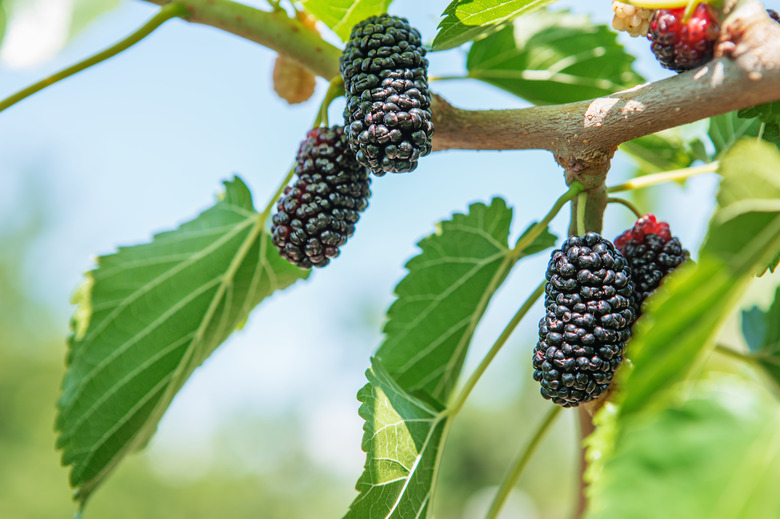Mulberry Tree Fungus Treatments
We may receive a commission on purchases made from links.
The Morus, or mulberry, genus consists of about 12 species of shrubs and trees, several of which — including red mulberry (Morus rubra) and white mulberry (Morus alba) — are commonly grown in the United States for their delicious fruits. Mulberry trees reach an average of 30 to 50 feet tall depending on the species, with white mulberry trees growing to around 40 feet tall and red mulberry trees reaching up to 60 feet in height.
While white mulberry trees can live up to 75 years, it's possible for red mulberry trees to live to the age of 125. That life span may be cut short, though, if the tree is infected with a fungal disease. When it comes to treating fungal infections on mulberry trees, it's important to start by identifying the type of fungus that's causing the infection to determine the proper course of action.
Leaf Spot Fungi
Leaf Spot Fungi
Cercospora moricola, C. missouriensis, and Cercosporella spp. fungi can cause leaf spotting on mulberry trees during seasons with heavy rain. Infections cause small gray or tan spots with a brown or purple border. These diseases may cause defoliation in some older trees but are typically benign on young, healthy trees. If defoliation starts to become a problem, apply a fungicide approved for use on leaf spot.
Powdery Mildew Fungi
Powdery Mildew Fungi
Powdery mildew is a common threat to mulberry trees and can be identified by a white powdery coating on the undersides and tops of leaves. If left untreated, leaves may become distorted, turn brown or yellow, and begin to fall off. To treat it, remove and destroy fallen leaves and spray infected foliage with a fungicide approved for powdery mildew.
Popcorn Disease (Ciboria carunculoides)
Popcorn Disease (Ciboria carunculoides)
This disease is only found in Southern states, and the main symptom is swelling of the carpels of the fruit, which will cause the berries to swell and never ripen. If you don't eat the mulberries from your tree and use it as an ornamental, no treatment is necessary.
If you value the berries, then in addition to pruning the tree for better air flow and removing infected plant material, you can create a fungicide blend known as a Bordeaux mixture to treat the infection. Combine 3 1/3 tablespoons of copper sulfate, 3 tablespoons of hydrated lime, and 1 gallon of water. Spray the solution on the entire tree if possible, applying it during the winter dormancy period to avoid damaging the leaves. This treatment will temporarily cause your tree to turn blue, but the color will return to normal after a short time.
False Mildew (Mycosphaerella mori)
False Mildew (Mycosphaerella mori)
Another disease found only in the South, false mildew typically appears in July. It starts with white patches on the underside of leaves and spreads to form a cobweblike coating similar to powdery mildew. Infected leaves fall to the ground and if left there, they will overwinter and infect the tree anew in spring. While false mildew may be difficult to distinguish from powdery mildew, the treatment is the same: Remove and destroy all fallen leaves and spray the plants with a suitable fungicide as soon as you notice an infection.
Cankers on Branches
Cankers on Branches
When cankers appear on your twigs and branches, they may be caused by one of at least six fungi, including Cytospora spp., Nectria spp., Gibberella baccata, Dothiorella spp., F. moricola, and Stemphylium spp. The only way to identify the specific fungus is to take a sample to your local extension office and have it perform scientific tests on the samples, but this is typically unnecessary. Simply pruning away and burning the infected branches as well as properly caring for your tree with adequate water and fertilizer may be enough to keep your tree healthy and successfully fight the infection.
References
- Texas A&M AgriLife Extension: Texas Plant Disease Handbook – Mulberry
- Texas A&M AgriLife Extension: Popcorn Disease on Mulberry
- University of Nebraska-Lincoln: Cercospora Leaf Spot
- University of Redlands: White Mulberry
- Purdue University: Red and White Mulberry in Indiana
- University of California Statewide Integrated Pest Management Program: Powdery Mildew on Fruits and Berries
- University of California Statewide Integrated Pest Management Program: Bordeaux Mixture
- U.S. Forest Service Southern Research Station: Red Mulberry
- Woody Plant Seed Manual: Moraceae—Mulberry Family: Morus L. – Mulberry
- Maine Organic Farmers and Gardeners: Grow Your Own Mulberries
